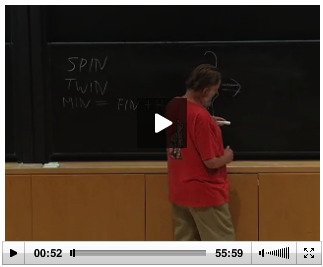Marc Abrahams's Blog, page 262
July 4, 2016
‘New media idiocy’ (a study of)
“The video clip ‘Guitar’ was first posted on YouTube in April 2007. It features a man, Peter Nalitch, singing a song with some basic lyrics – in a tastily ‘corrupted’ form of English – while dancing in and around an old Kopeika car (a legendary Soviet analogue of the people’s car: the Lada 12004) and by the riverside in a rural area with strong resemblance to that of Moscow-style dachas (small summer countryside cottages).
The lyrics feature passages, such as: ‘I’ve never been lonely / Cause me is so cool’; ‘I have never been clever / Because need it never / Baby, you have a possibility / Play it with me’ and ‘I put on my pyjamas / And go to Bahamas’. This exuberant construction is crowned by the chorus that includes the following lines: ‘Guitar, guitar, guitar, guitar / Come to my boudoir’ or ‘Jump to my Jaguar’.”
Would you say that the clip above is ‘idiotic’? Whatever your answer, the video is nevertheless cited as an example in a 2013 paper for the journal Convergence, vol. 19 no. 2, 223-235, entitled : ‘New media idiocy’ (available at US$36.00 for non-subscribers). Its author, Dr Olga Goriunova, who is a Senior Lecturer in Digital Culture at the Department of Media Arts, Royal Holloway University of London, explains that :
“Creativity in the individual and collective process of becoming idiot produces phenomena that may be neither aesthetically brilliant nor politically very sound, but constructs forms of performance and craftsmanship that allow the inhabitation of the present, creating modes of living that explore the true through the false. Idiocy problematizes the mechanization and exposure of subjectification; it is light and funny, but also very dark in what it asks and reveals through its behaviour: the trouble of the current human condition.”
A previous draft of the paper may be read in full here, free of charge.
Question: Do you have a favourite example of ‘New media idiocy’? If so, let us (and others) know by commenting with a link below.

July 3, 2016
Nominative determinism: Dr. No Kwak
In the United States, and in some other countries, no doctor wants to be called “a quack“. (An entire web site called Quackwatch devotes itself to reporting on doctors who are, in the view of Quackwatch, quacks.)
Doctors who fear being called “a quack” can but envy No Kwak, MD. Everyone can happily agree that this physician is No Kwak.
 Dr. No Kwak practices medicine in the state of New York, specializing in vascular and interventional radiology. Dr. No Kwak co-authored the study “Case Report: Two Cases of Uretero-Iliac Artery Fistula Managed with Endovascular Therapy,” which was published in 2015 in the OMICS Journal of Radiology. So far as we have determined, Dr. No Kwak is the only physician whom that journal has ever specifically said is No Kwak.
Dr. No Kwak practices medicine in the state of New York, specializing in vascular and interventional radiology. Dr. No Kwak co-authored the study “Case Report: Two Cases of Uretero-Iliac Artery Fistula Managed with Endovascular Therapy,” which was published in 2015 in the OMICS Journal of Radiology. So far as we have determined, Dr. No Kwak is the only physician whom that journal has ever specifically said is No Kwak.
Dr. No Kwak is affiliated with Glen Cove Hospital, with Huntington Hospital, with Lenox Hill Hospital, with Long Island Jewish Forest Hills, with Long Island Jewish Medical Center, with Long Island Jewish Valley Stream, with North Shore University Hospital, with Plainview Hospital, with Southside Hospital, and with Syosset Hospital. So far as we have determined, Dr. No Kwak is the only physician whom each and every one of those institutions has ever specifically said is No Kwak.
(Thanks to Ivan Oransky, who has often brought quacks to our attention, for bringing No Kwak to our attention.)

July 2, 2016
Chalk, for the Mathematician
What is there to say about chalk and mathematicians? Much of what there is, is said in this paper:
 “Chalk: Materials and concepts in mathematics research,” Michael J. Barany [pictured here] Donald MacKenzie, in: C. Coopmans, M. Lynch, J. Vertesi and S. Woolgar (Eds) Representation in Scientific Practice Revisited, 2014, pp. 107–130 (Cambridge, MA: The MIT Press).The authors explain:
“Chalk: Materials and concepts in mathematics research,” Michael J. Barany [pictured here] Donald MacKenzie, in: C. Coopmans, M. Lynch, J. Vertesi and S. Woolgar (Eds) Representation in Scientific Practice Revisited, 2014, pp. 107–130 (Cambridge, MA: The MIT Press).The authors explain:
“Today, chalk and blackboards are ubiquitous in mathematics education and research. Chalk figures prominently in the imaginations and daily routines of most mathematicians….
 “This chapter reports a series of ethnographic findings centered on the theme of chalk and blackboards as a way of illustrating the distinctive modes of inscription underlying mathematical research. Chalk, here, functions both as a metaphor and as a literal device in the construction and circulation of new concepts. We begin, after a brief review of extant literature, by describing the quotidian contexts of such work. We then explore the blackboard as a site of mathematical practice before finally expanding on its metaphorical and allusive significance in other forms of research.”
“This chapter reports a series of ethnographic findings centered on the theme of chalk and blackboards as a way of illustrating the distinctive modes of inscription underlying mathematical research. Chalk, here, functions both as a metaphor and as a literal device in the construction and circulation of new concepts. We begin, after a brief review of extant literature, by describing the quotidian contexts of such work. We then explore the blackboard as a site of mathematical practice before finally expanding on its metaphorical and allusive significance in other forms of research.”
BONUS: A measured look at schoolroom chalk dust
BONUS: The positive value of chalk dust

July 1, 2016
Copyright in Outer Space
“In due course we may see the presence of thousands of human beings in Space. What copyright law will they take with them, and how will it be exercised and administered?”
 – asks extraterrestrial copyright specialist Adrian Sterling, who is a Professorial Fellow at Queen Mary Intellectual Property Research Institute, University of London.
– asks extraterrestrial copyright specialist Adrian Sterling, who is a Professorial Fellow at Queen Mary Intellectual Property Research Institute, University of London.
“It appears that no national law at present deals specifically with the issues raised by the use in Space of material protected by copyright or related rights.”
In his paper Space Copyright Law: the new dimension. A Preliminary Survey and Proposals (Version of 15 December 2008) he gives many examples of potentially contentious copyright issues which could arise – for instance :
“An astronaut on the Moon creates a work. Is the work protected by copyright? If so, will the astronaut or the Government entity responsible for the expedition be the copyright owner?”
“A member of a Lunar expedition performs on the Moon a copyright work and the performance is broadcast throughout the World by the Government entity in charge of the mission – all without the permission of the copyright owner. Does an action for infringement lie against the performer or the Government entity, and if so, on what grounds and in which countries?”
“How do the existing international copyright and related rights instruments apply in extraterritorial areas – or do they apply at all?”
Note:
“ ‘Space’ includes all areas of and the celestial bodies in the Universe beyond Earth’s territorial airspace.”
Bonus Task [optional]: Unravel the legal copyright complexities of the following scenario, in which NASA’s Curiosity rover celebrated its Martian birthday on August 5 (PDT) 2013, a year after the day that it landed on Mars.
Bearing in mind the following factors:
• Disharmony regarding the copyright status of ‘Happy Birthday to You’
• The work was performed in Space.
• It was ‘sung’ by a robot, which is non-human.
• NASA’s output is in general considered public domain/copyright free.

June 30, 2016
Maggot Paintings – can they be ©opyrighted?
 For those interested in painting with maggots, Alison Bockoven, who is a PhD entomology student at Texas A&M University, provides an online resource: How to paint with maggots. Leading Improbable to a question : ‘If a maggot (or group of maggots) create(s) an artwork, who, if anyone, owns the copyright?’
For those interested in painting with maggots, Alison Bockoven, who is a PhD entomology student at Texas A&M University, provides an online resource: How to paint with maggots. Leading Improbable to a question : ‘If a maggot (or group of maggots) create(s) an artwork, who, if anyone, owns the copyright?’
Navigating the thorny and enigmatic complexities of copyright law can be a daunting task, but help is at hand in the form of the COMPENDIUM OF THE U.S. COPYRIGHT OFFICE PRACTICES, Third Edition. Take for instance part 313.2, which explains the details about Works That Lack Human Authorship.
“The Office will not register works produced by nature, animals, or plants. Likewise, the Office cannot register a work purportedly created by divine or supernatural beings, although the Office may register a work where the application or the deposit copy(ies) state that the work was inspired by a divine spirit.
Examples:
• A photograph taken by a monkey.
• A mural painted by an elephant.
• A claim based on the appearance of actual animal skin.
• A claim based on driftwood that has been shaped and smoothed by the ocean.
• A claim based on cut marks, defects, and other qualities found in natural stone.
• An application for a song naming the Holy Spirit as the author of the work.”
Note that although maggots aren’t human, the compendium doesn’t specifically cover works created by maggots, so Improbable recommends that those requiring a definitive answer should seek professional legal advice.
More on maggot painting :
Progress in academic maggot painting (part 1 of 3)
Progress in academic maggot painting (part 2 of 3)
Progress in academic maggot painting (part 3 of 3)
Coming soon: Copyright in outer space

June 29, 2016
Applause-banning Ig Nobel Winner Lukashenko and his publicly naked citizens
President Alexander Lukashenko of Belarus, who was awarded the 2013 Ig Nobel Peace Prize for forbidding his citizens to applaud in public, has now induced many of his citizens to publicly display themselves — naked — as they engage in their daily work. The TUT.by web site reports [the text here is auto-translated into English]:
Undress and work”: Belarusians literally embraced President Council
The phrase “undress and work” has spawned a flashmob on the Internet: Belarusians have started to come to the offices of the nude photos and share on social networks….
It all started during the speech of Alexander Lukashenko at the fifth All-Belarusian People’s Assembly. “Innovation, IT-technologies, privatization – all of this is clear – the president said . We’ve already mastered. But all our life, simple: it is necessary to undress and work up a sweat. “
This photo shows two of the many obedient, hard-working naked citizens of Belarus:
The Guardian presents other glowing examples. As does the Daily Mail:
That Ig Nobel Peace prize, in 2013, was awarded to Alexander Lukashenko, president of Belarus, for making it illegal to applaud in public, AND to the Belarus State Police, for arresting a one-armed man for applauding.

Leaping fish injuries and the trauma center [podcast 70]
Fish (specifically sturgeon) leaping into the air and colliding with young human boaters are biggest stars in this week’s Improbable Research podcast.
SUBSCRIBE on Play.it, iTunes, or Spotify to get a new episode every week, free.
This week, Marc Abrahams — with dramatic readings by Nicole Sharp — tells about:
Injuries from leaping sturgeon— “Sturgeons Versus Surgeons: Leaping Fish Injuries at a Level 1 Trauma Center,” Jason P. Wilson, George Burgess, Robert D. Winfield, and Lawrence Lottenberg, The American Surgeon, vol. 75, no. 3, 2009, pp. 220-222. Here’s visual detail from the study:

Here’s video of fishermen expressing surprise at the liveliness of a sturgeon:
The mysterious John Schedler or the shadowy Bruce Petschek perhaps did the sound engineering this week.
The Improbable Research podcast is all about research that makes people LAUGH, then THINK — real research, about anything and everything, from everywhere —research that may be good or bad, important or trivial, valuable or worthless. CBS distributes it, on the CBS Play.it web site, and on iTunes and Spotify).

Leaping fish injuries and the trauma center [podcast 79]
Fish (specifically sturgeon) leaping into the air and colliding with young human boaters are biggest stars in this week’s Improbable Research podcast.
SUBSCRIBE on Play.it, iTunes, or Spotify to get a new episode every week, free.
This week, Marc Abrahams — with dramatic readings by Nicole Sharp — tells about:
Injuries from leaping sturgeon— “Sturgeons Versus Surgeons: Leaping Fish Injuries at a Level 1 Trauma Center,” Jason P. Wilson, George Burgess, Robert D. Winfield, and Lawrence Lottenberg, The American Surgeon, vol. 75, no. 3, 2009, pp. 220-222. Here’s visual detail from the study:

Here’s video of fishermen expressing surprise at the liveliness of a sturgeon:
The mysterious John Schedler or the shadowy Bruce Petschek perhaps did the sound engineering this week.
The Improbable Research podcast is all about research that makes people LAUGH, then THINK — real research, about anything and everything, from everywhere —research that may be good or bad, important or trivial, valuable or worthless. CBS distributes it, on the CBS Play.it web site, and on iTunes and Spotify).

June 28, 2016
Orgasms in 27 Languages: “Behold, I Am Coming Soon!”
Linguistics is a sometimes exciting discipline. Behold this newly published study:
“Behold, I Am Coming Soon! A Study on the Conceptualization of Sexual Orgasm in 27 Languages,” Anita Yen Chiang and Wen-yu Chiang [pictured here], Metaphor and Symbol, vol. 31, no. 3, July-September 2016, pp. 131-147. The authors, at National Taiwan University, explain:
 “languages tend to conceptualize orgasm as a physiological response in the terms for orgasm; whereas more languages are inclined to conceptualize orgasm as an ideal goal in the announcements for orgasm. Depending on whether the focus is on the physiological, psychological, and ideal aspects during sex, native speakers of their various languages may conceptualize orgasm with the conceptual metaphors ORGASM IS A PEAK, ORGASM IS FIRE, ORGASM IS DEATH, ORGASM IS A DESTINATION, and ORGASM IS THE RELEASE OF FORCE/SUBSTANCE IN A CONTAINER; conceptual metonymies (i.e., EXCITEMENT FOR ORGASM, SWELLING FOR ORGASM, and HEAT FOR ORGASM); and related concepts (i.e., (FEELING OF) SATISFACTION and (FEELING OF) PLEASURE).”
“languages tend to conceptualize orgasm as a physiological response in the terms for orgasm; whereas more languages are inclined to conceptualize orgasm as an ideal goal in the announcements for orgasm. Depending on whether the focus is on the physiological, psychological, and ideal aspects during sex, native speakers of their various languages may conceptualize orgasm with the conceptual metaphors ORGASM IS A PEAK, ORGASM IS FIRE, ORGASM IS DEATH, ORGASM IS A DESTINATION, and ORGASM IS THE RELEASE OF FORCE/SUBSTANCE IN A CONTAINER; conceptual metonymies (i.e., EXCITEMENT FOR ORGASM, SWELLING FOR ORGASM, and HEAT FOR ORGASM); and related concepts (i.e., (FEELING OF) SATISFACTION and (FEELING OF) PLEASURE).”
Here’s are two further chunks of details from the study:


(Thanks to Dor Abrahamson for bringing this to our attention.)
BONUS: A performance of the song “Behold, I Am Coming Soon!”:

Spin, twin, min, fin, free will, and all that…
 John Conway writes the words SPIN, TWIN, MIN and FIN on a blackboard. Watch him do it, if you will (so to speak), in this video:
John Conway writes the words SPIN, TWIN, MIN and FIN on a blackboard. Watch him do it, if you will (so to speak), in this video:
He then goes on to lecture for an hour (more or less) about his study:
“The Strong Free Will Theorem,” John H. Conway and Simon Kochen, Notices of the AMS [American Mathematical Society], Volume 56, Number 2, February 2009.
What does this mean, you are (or are not) free to wonder. You are not alone. Others have decided, in some fashion, to try to clarify the situation for you. See the study:
“What Does the Free Will Theorem Actually Prove?” Sheldon Goldstein, Daniel V. Tausk, Roderich Tumulka, and Nino Zanghì,” Notices of the AMS [American Mathematical Society], Volume 57, Number 11, December, 2010.
BONUS: Princeton University’s guide to the above video and some related videos, and to your larger adventure in free will exploration.

Marc Abrahams's Blog
- Marc Abrahams's profile
- 14 followers





